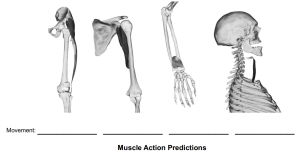24 Post-Lab for Muscles
Gillian Backus; Heidi W. Wangerin; and Paula Rodgers
Post-lab: Muscles Lab
Name: ________________________
Lab Checkout:
When you finish the lab, please clean up your lab space and put away your materials neatly in the tray. Once you have thoroughly cleaned, washed, and dried your lab table, please get your instructor’s initials to check-out of lab.
- Lab bench clean, washed, and dried
- Materials put away properly and organized in trays
- Microscope properly put away
Lab completed (% completed = ______ %) Instructor initials: ______________
Activity 1: Muscle Actions
1. How does one determine the action of a muscle, using knowledge of the origin and insertion?
2. Some muscles, like the flexor carpi ulnaris, are defined both as agonists and antagonists. Explain how this is possible using the flexor carpi ulnaris as an example.
Activity 2 & 3: Muscles of the Axial and Appendicular Skeleton
3. Name the muscle(s) that is/are true for each statement. Use muscles only from your terminology sheet.
___________________ flexes the thigh
___________________ extends the digits
________________ insertion on the mastoid process of the temporal bone
__________________ insertion above the eyebrows, near frontal bone
___________________ abducts the arm
___________________ flexes the trunk
___________________ Insertion is on humerus
___________________ adduction of the leg
___________________ plantarflexion of the foot
___________________ origin is the vertebral column
___________________ causes pursing of the lips
___________________ pronates the arm
4. Name the four muscles that make up the quadriceps femoris.
- ___________________
- ___________________
- ___________________
- ___________________
5. Name the three muscles that make up the hamstring set.
- ___________________
- ___________________
- ___________________
6. Name the three muscles of the rotator cuff.
- ___________________
- ___________________
- ___________________
7. Below each image write the main action of the muscle group.
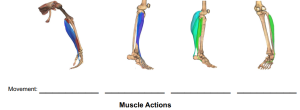
8. Color the bullet point (or term) and the corresponding muscle on the anterior view of the body muscles in the same color:
- adductor longus
- biceps brachii
- brachioradialis
- buccinator
- deltoid
- extensor digitorum longus (leg)
- external oblique
- fibularis longus
- flexor carpi radialis
- flexor carpi ulnaris
- frontalis
- gracilis
- iliopsoas
- internal oblique
- masseter
- orbicularis oculi
- orbicularis oris
- pectoralis major
- platysma
- pronator teres
- rectus abdominis
- rectus femoris
- sartorius
- serratus anterior
- sternocleidomastoid
- temporalis
- tibialis anterior
- transverse abdominis
- vastus lateralis
- vastus medialis
- zygomaticus
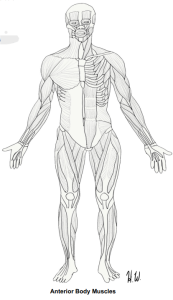
9. Color the bullet point (or term) and the corresponding muscle on the posterior view of the body muscles in the same color:
- adductor magnus
- biceps femoris
- deltoid
- gastrocnemius
- gluteus maximus
- gluteus medius
- gracilis
- latissimus dorsi
- occipitalis
- rhomboid
- semimembranosus
- semitendinosus
- soleus
- teres major
- trapezius
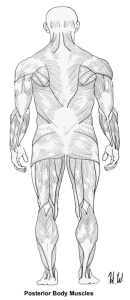
The following questions are an application of what you have learned. The muscles are not muscles you need to know but are instead used to apply the skills you have learned in this lab.
10. Given the name and action of a muscle, draw the muscle’s insertion and origin on the image of the lower limb to the right. Don’t look up the muscle but think about what the name tells you about its location on the body. Think about where the muscle would have to start and end to generate the movement.
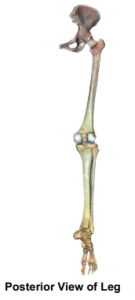
a. Tibialis posterior, action: foot inversion and plantar flexes
b. Adductor brevis, action: to adduct the hip joint
11. Apply it! View the images below and pay close attention to the attachment points of the muscle to the skeleton. These are not muscles that you need to know. Multiple answers will be accepted! Predict the action of each muscle.
